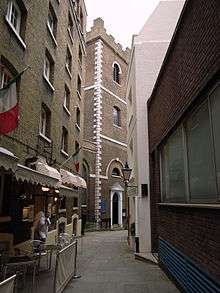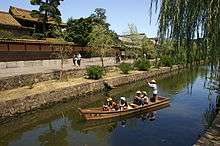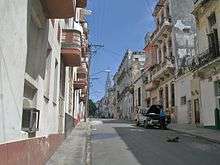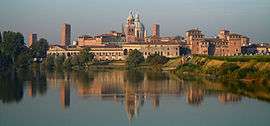Old towns
An old town, or a historic district, is a town, district, or neighborhood with a significant number of preserved buildings from a bygone era. They often have a nostalgic feel and are considered to be one of the best ways to get a feel for what life was like long ago. The oldest towns have existed since before the beginning of the common era. Several old towns are recognized on the UNESCO World Heritage List.
Understand
|
Urban legend: A guided tour in a European city The tour guide:
|
An old town is inhabited, in contrast to archaeological sites and ghost towns.
The old towns that exist today are not necessarily the first settlements built at the location. Many of them have been destroyed and rebuilt several times. Some old towns, such as Düsseldorf, have been restored to their former appearance in recent times.
Foreign-language terms for old town:
- Arabic: Medina (المدينة - not to be confused with the Saudi Arabian city of the same name).
- Catalan: Ciutat vella
- Chinese: gǔ zhèn (古镇/古鎮)
- Czech: Staré město
- Dutch: Oude stad or historische binnenstad
- French: Vieille ville, Vieux-(...) or Centre historique
- German: Altstadt
- Indonesian: Kota tua or kota lama
- Italian: Città Vecchia or Centro Storico
- Japanese: Machinami (街並み or 町並み)
- Portuguese: Cidade Velha or Centro Histórico
- Serbo-Croatian: Stari Grad
- Spanish: Ciudad Vieja or Centro Histórico
- Welsh: Hen dref
Get around

Old towns usually have narrow streets and even narrower alleys, where pedestrians move more easily than automobiles. Distances are rarely very great, since the town was invariably constructed in an era when most people had to walk everywhere and wasting space by having houses be far apart from another would thus have seemed supremely pointless to the people who built those towns.
Pre-modern cities typically had less than 100,000 inhabitants (with a few exceptions, such as Rome, Constantinople, Tenochtitlan and Beijing) and were densely populated, so they are usually less than 1 km across. Due to grade separation, staircases and cobblestone, travellers with disabilities might have difficulties to get through some points. Wheeled suitcases, strollers and bicycles can also be hard to get through. Riding a bike is further complicated by the often dense pedestrian traffic and getting off and pushing it is often the smarter choice if you have to get your bike from one end of the old town to the other.
Entering an old town by automobile can be physically impossible, illegal, or at least very difficult. Even if the road is wide enough for a motorcar, some old towns (particularly Quebec City) are built on steep slopes as a cliff-top or hillside location made the city historically easier to defend against a ground or sea attack. Parking a car outside but near an old town can also be difficult and/or expensive. Citizens who have a car at all, usually have a compact model.
Some old towns have gotten some connections to public transport, though in many cases they are rather radial lines bypassing the (narrow) historic core and even long distance transport infrastructure such as train stations have often been constructed outside the old town. Where stations were constructed inside the city walls, it was often the determining factor in (at least partially) tearing them down to make room for the rails. The Napoleonic wars as well as the railway boom shortly thereafter are one of the main reasons so many European old towns have no walls any more. Those city walls that survived this double blow were often razed by bombing in the second world war or torn down to make room for cars. In the latter case the former city wall may still be evident in name and orientation of some city streets.
See
Architecture in old towns can be totally unique. Many old towns are dominated by city walls or other fortifications, together with palaces and religious buildings (churches, mosques, temples, synagogues etc.). Non-government profane buildings can be prominent in merchant cities, such as Venice or old Hanseatic towns.
In some of the old towns, a building is converted to an art, science, historical or biographical museum. A house where a famous person was born or had lived may become a museum about that person's life and work, giving visitors a chance to see the inside of the building as well as the exhibits themselves. Often, several buildings close to one another are converted to different individual museums. Religious buildings are often still in use for religious functions (though some religious buildings have been "rededicated" from church to mosque or from temple to church or vice versa) but can be open for viewing like a museum when the building is not in use for religious functions which take precedent. Many historically important religious buildings in old towns don't have their "own" congregation assigned to them and if you are of a compatible religious orientation you may very well join a service. Rules for indoor photography vary and can be sensitive or even prohibited as in religious settings (such as the Mayan churches in southern Mexico & Guatemala). Some are free to enter while others charge an admission at varying rates or you decide on a donation basis. Other buildings can be converted into government offices, hotels, retail spaces and for other private uses that offer limited or no public access.
Do
Several old towns are served by horse-carriage rides, in old-style carriages. These are often costly, far from genuine, and should primarily be considered if a guided tour is included.
Several old towns have traditional festivals, connecting to their past heritage. Whether carried on since old times (such as Sechseläuten in Zürich), or made up by posterity (such as the Medieval Week in Visby), they can provide an experience beyond the usual, as well as overcrowded venues.
Particularly in (formerly) German-speaking areas Christmas markets are often held in old towns, with some having a tradition of half a millennium or more.
Buy
Old towns usually contain different kinds of shopping: traditional arts and crafts, as well as mass-produced souvenirs and mundane shopping.
Eat
As old towns are frequented by travellers, meals can be overpriced and only so-so quality wise. Due to lack of modern utilities, hygiene might be deficient. However, good restaurants can also be found. The best places to eat are places popular with locals. Besides a more authentic dining experience, the restaurant owners have greater incentive to keep people coming back, who might even bring a guest, and to maintain a positive reputation among the locals. Avoid restaurants that are devoid of people as there is a reason why business is lousy there. Be wary of restaurants no local goes to.
Sleep
The accommodation inside the old towns can be limited in size and comfort, compared to the Grand Old Hotels of the late-19th century. The available accommodations can be anything from zero star flop houses to five star boutique hotels or anything in between. Some may even be international chains that fit into the old style architecture. Therefore, rooms are rarely standardized, you should have a look at the room or better yet at several rooms as one may be in better condition in a quieter location than the other, or at least have a description, before you make the deal.
Stay safe

As old towns can be packed with people, be aware of common scams as well as pickpockets. Street lighting might be deficient in old towns. As some old towns still have cobblestones, walk carefully when they are wet or you are wearing high heels or pumps (better yet, wear footwear that provides you with good traction).
Though some places have extremely safe old towns where you can walk around at any hour of the day or night without concern, there are some cities whose old towns are high-crime neighborhoods or oases surrounded by bad neighborhoods (such as Casco Viejo in Panama or La Candelaria in Bogota, Colombia), where muggings or assaults can happen. In such cases, take care if you are going out, especially if you go clubbing and get drunk at night. Stay on busy, well-lit streets where there are people walking about and don't wander onto deserted side streets. Use taxis to get around if necessary. There are also old towns in conflict zones hit by civil unrest, terrorism, warfare and/or lawlessness where kidnapping is rife or bullets can be flying overhead in every direction (such as those in Yemen, Syria, Iraq, Libya, Egypt, etc.). Many of the restaurants, hotels, stores and sights mentioned in those articles (written before the conflict) may be closed or destroyed in the conflict, so inquire locally as to what is still available, or better yet, if you can avoid travel to conflict zones, do not go there in the first place. In peaceful areas that were formerly conflict zones (such as those in the Balkans), there may still be landmines in the surrounding countryside. See the War zone safety article and your country's foreign ministry website on travel safety for further information.
Famous old towns
This incomplete list includes inhabited urban districts of decent size and population, open to the public, that have remained largely intact since around 1850, or have been faithfully restored to that state.
Europe & the Caucasus
- See also: European history

While a few South European cities date back to Ancient Greece or the Roman Empire, most were founded during the Middle Ages (AD 500-1500). Some of these cities were visited by the young elite on their Grand Tour. Some of them bear scars from warfare, especially World War II, when some cities lost as much as 90% of their pre-war buildings. Due to the wars as well as overzealous city planners from the 19th to the first half of the 20th century, some towns that have long lost their former importance actually have better preserved old towns than more notable cities. Several old towns (not least in Germany and Italy) were once independent or de facto independent city-states. Today, just a few of them fly their own flag (Monaco, San Marino etc.). Others were part of empires, such as the Austrian Empire, the Ottoman Empire, or the Russian Empire.
- Albania: Berat, Gjirokastër
- Andorra: Andorra la Vella
- Austria: Innsbruck, Salzburg, Vienna/Innere Stadt
- Azerbaijan: Baku
- Belgium: Antwerp, Bruges, Ghent, Kortrijk, Leuven, Mechelen
- Bosnia and Herzegovina: Mostar
- Bulgaria: Sofia, Plovdiv, Varna
- Croatia: Dubrovnik, Trogir, Pula, Split
- Czech Republic: Prague, Cesky Krumlov, Telc
- Denmark: Aarhus, Copenhagen/Indre By, Copenhagen/Christianshavn, Helsingor, Odense, Roskilde, Ribe
- Estonia: Pärnu, Tallinn
- Finland: Rauma, Porvoo
- France: Autun, Avignon, Bordeaux, Carcassonne, Honfleur, Lyon, Limoges, Mont Saint-Michel, Mulhouse, Nantes, Nice, Strasbourg, Tours, Toulouse, Vézelay, Paris/4e (Medieval Paris, Ile de la Cité, Notre Dame on right side of River Seine); Paris/5e (le quartier Latin/Latin Quarter on left of River Seine); the small medieval towns along the Alsatian Vineyard Route; The Most Beautiful Villages of France
- Georgia: Tbilisi, Mtskheta
- Germany (see also Hanseatic League)
- Bamberg castle and churches galore seat of a formerly powerful archbishop popular with Americans as it is close to a former US barracks,
- Cologne with the famous cathedral ("Kölner Dom"),
- Düsseldorf Cologne's old rival, rebuilt after the war
- Dresden The "Florence of the Elbe" much of it destroyed in the second world war (but rebuilt much like it was before)
- Erfurt,
- Göttingen,
- Goslar,
- Heidelberg,
- Lübeck formerly the heart of the Hanse severely destroyed in the second world war now mostly restored to her former beauty,
- Munich/City Center,
- Nuremberg a medieval and early modern gem, complete with castle and half timbered houses, even though much of it was destroyed and rebuilt because of World War II.
- Quedlinburg old imperial town of the Ottonian dynasty of the 10th and 11th century AD,
- Rothenburg ob der Tauber virtually untouched by war since the thirty years war in the 17th century one of the few cities to still have an intact city wall,
- Stralsund old hanseatic city,
- Trier oldest city in Germany, famous for its Roman Porta Nigra (Latin for black gate),
- Wismar another former member of the Hanse
- Greece: Athens/Plaka, Corfu, Rhodes
- Hungary: Budapest/Castle Hill, Eger, Győr
- Italy: See also Medieval and Renaissance Italy.
- Kosovo: Prizren
- Latvia: Riga
- Lithuania: Kaunas, Klaipeda, Trakai, Vilnius
- Luxembourg: Luxembourg, Echternach
- Macedonia: Ohrid, Skopje/Stara Čaršija
- Monaco: Monaco-Ville
- Montenegro: Budva, Herceg Novi, Kotor
- Netherlands: Amsterdam (Centrum and Canal District), Den Bosch, Delft, Gouda, The Hague, Heerlen, Leiden, Maastricht, Nijmegen, Utrecht, Voorburg, Zutphen.
- Norway: Bergen, Trondheim
- Poland: Gdańsk, Gniezno, Krakow, Lublin, Poznań, Toruń, Warsaw, Wrocław
- Portugal: Aveiro, Braga, Bragança, Coimbra, Évora, Guimarães, Lisbon, Óbidos, Porto
- Romania: Iași, Sibiu, Sighisoara
- Russia: Derbent, Kostroma, Novgorod, Pskov, Rostov Veliky, Staraya Russa, Saint Petersburg, Suzdal, Vladimir, Vyborg, Yaroslavl
- Serbia: Belgrade, Niš, Novi Sad
- San Marino
- Spain: Avila, Barcelona/Ciutat Vella, Burgos, Cadiz, Córdoba, Cuenca, León, Granada, Madrid/Centro, Salamanca, San Sebastian, Santiago de Compostela, Segovia, Tarragona, Toledo, Ubeda
- Sweden: Stockholm/Gamla Stan, Lund, Visby, Uppsala, Sigtuna, Gävle, Karlskrona, Söderköping, Ystad
- Switzerland: Basel, Berne, Geneva, Lugano, Saint Gallen, Thun, Zürich
- Ukraine: Chernivtsi, Lviv, Odessa
- United Kingdom: Bath, Canterbury, Hastings, Gloucester,Southampton, Stratford upon Avon, Edinburgh/Old Town, Oxford, York. Sir Alec Clifton Taylor also noted Berwick-upon-Tweed, Beverley, Bradford on Avon, Bury St Edmunds, Chichester, Cirencester, Devizes,Durham, Lewes, Ludlow, Richmond, Saffron Walden, Sandwich, Stamford, Tewkesbury, Totnes, Warwick and Whitby of specific interest, in a series of BBC documentaries.
- Vatican City
Middle East

The Middle East contains many of the world's oldest cities, some of them inhabited for several thousand years.
- Cyprus: Nicosia, Famagusta, Kyrenia, Limassol
- Lebanon: Tyre
- Iran: Isfahan, Mashhad, Qom, Shiraz
- Iraq: Baghdad, Mosul
- Israel/Palestine: Akko, Bethlehem, Hebron, Jerusalem/Old City, Jaffa, Jericho, Tiberias
- Jordan: Amman
- Saudi Arabia: Jeddah, Diriyah, Mecca, Medina
- Syria: Aleppo, Bosra, Damascus
- Turkey: Adana, Amasya, Antakya, Antalya, Ayvalık, Beypazarı, Bursa, Edirne, Eskişehir (Odunpazarı), Istanbul/Sultanahmet-Old City, Kayseri, Konya, Mardin, Safranbolu, Sinop, Sivas, Tarsus, Trabzon, Urfa
- Yemen: Sana'a, Aden, Shibam, Zabid
Asia

- Bangladesh: Dhaka/Old Dhaka
- China: Dali, Dengfeng, Heshun, Kashgar, Hongcun, Kaiping, Lhasa, Lijiang, Macao, Nanjing, Pingyao, Qufu, Shanghai/Bund, Shanghai/Old City, Suzhou, Xidi, Yinxu, Zhouzhuang
- Several parts of China also have "water towns" with many canals and picturesque older buildings; some are within modern cities and some not. One list is here.
- India : Allahabad, Ayodhya, Delhi#Old_Delhi, Jaisalmer, Jodhpur, Mathura, Mumbai/South, Old Goa, Rajgir, Sanchi, Udaipur, Ujjain, Varanasi
- Indonesia: Jakarta/West (old Batavia & Chinatown), Jakarta/North (part of old Batavia), Semarang, Solo, Yogyakarta
- Japan: Hagi, Kakunodate, Kameyama, Kanazawa, Katori, Kawagoe, Kurashiki, Kurayoshi, Kyoto, Nichinan, Omihachiman, Shimogo (Ouchi-juku) Shiojiri, Shirakawa-go, Fukiya Takayama, Taketomi, Toyooka (Izushi), Uchiko, Yame, Yanai
- Laos: Luang Prabang, Vientiane
- Malaysia: Georgetown (historic buildings are mostly from the 19th and early 20th centuries, but that's old for surviving buildings in Malaysia), Ipoh (ditto to remarks on Georgetown's historic buildings), Kuching (again, some 19th-century buildings), Malacca (the small Heritage Area has truly old buildings, dating back as far as the 16th century)
- Myanmar: Yangon
- North Korea: Kaesong
- Pakistan: Karachi, Lahore, Peshawar
- Philippines: Baclayon, Iloilo, Laoag, Loboc, Santa Maria, Vigan
- South Korea: Jongno and Jung in Seoul, Hahoe, Yangdong
- Taiwan: Jiufen, Tainan
- Uzbekistan: Bukhara, Samarkand, Shakhrizabz
- Vietnam: Hanoi, Hue, Hoi An
Africa
Most old towns in North and East Africa have an Arabic (or at least Islamic) heritage, but some have an even earlier history.
- Algeria: Casbah of Algiers, Ghardaïa
- Cape Verde: Cidade Velha; Founded in 1462, this is one of the oldest European colonial cities
- Egypt: Cairo/Old Cairo, Alexandria
- Ethiopia: Axum (Aksum), Harar
- Kenya: Lamu, Mombasa
- Libya: Tripoli
- Malawi: Zomba
- Mali: Djenné, Timbuktu
- Morocco: Chefchaouen, El Jadida, Meknes, Rabat, Essouira, Fez, Marrakech, Tangier, Tetouan, and the Ksar of Ait-Benhaddou
- South Africa: Cape Town
- Tanzania: Stone Town
- Tunisia: Tunis
Americas
- See also: Early United States history

The Americas have some colonial old towns from the time between the European arrival in 1492, and the independence movements of the late 18th and early 19th centuries. Most of these are in the Caribbean (current and former English, Dutch, French & Spanish territories), New Spain (modern day Mexico, Southwestern US, Cuba & Puerto Rico) or in the coastal areas of the rest of Latin America. Some colonial cities were actually built in or close to indigenous settlements but hardly any traces of the pre-1492 cities remain today while many were built as centers of trade in the interior such as those in Mexico, Peru and Bolivia as a trade hub for the surrounding silver mines.
- Barbados: Bridgetown
- Bermuda: Saint George
- Bolivia: Potosí, Sucre
- Brazil: Mariana, Ouro Preto, Olinda, Paraty, Pirenópolis, Salvador, São Cristóvão, São Luís, Tiradentes
- Canada: Lunenburg (dates back to the 18th century, with other buildings from the 19th century), Montreal/Old Montreal (includes 17th-19th-century buildings), Quebec City (the most famous old town in Canada, very reminiscent of European old towns). Ottawa also has some claim to being an old town by Canadian standards, as much of its historical center is composed of old low-rise buildings from the early to mid 19th century, plus other later ones built in a compatible style.
- Chile: Valparaíso
- Colombia: Bogotá/La Candelaria, Barichara, Cartagena, Jardín, Santa Cruz de Mompox, Santa Fe de Antioquia, Tunja, Villa de Leyva, Zipaquirá
- Cuba: Cienfuegos, Havana, Trinidad
- Curaçao: Willemstad
- Dominican Republic: Santo Domingo
- Ecuador: Quito, Cuenca
- Guatemala: Antigua Guatemala
- Mexico: Alamos, Campeche, Guanajuato, Mexico City/Centro, Xochimilco, Merida, Morelia, Oaxaca, Patzcuaro, Puebla, Real de Catorce, San Cristobal de las Casas, San Luis Potosi, San Miguel de Allende, Taxco, Zacatecas
- Nicaragua: Leon and its old arch-rival Granada
- Peru: Arequipa, Ayacucho, Cuzco, Lima/Central, Ollantaytambo, Trujillo
- Puerto Rico: San Juan/Old San Juan, San German
- United States: Boston/Downtown; Charleston SC; Charles Town WV; Frederick MD; Gloucester MA; Harpers Ferry WV; Leesburg VA; New Orleans/French Quarter; New York City, Philadelphia/Old City, Port Townsend WA; Portland ME/Old Port; Salem MA; St Augustine FL; San Antonio TX; San Diego/Old Town-Mission Valley; Savannah GA; Santa Fe NM; Taos NM; Washington, D.C./Georgetown; Williamsburg VA; Virginia City, NV.
- See the Old West article for a list of additional cities and towns in the old west.
- Uruguay: Montevideo, Colonia del Sacramento
- Venezuela: Coro
Oceania
.jpg)
Oceania's old towns are not as old as the ones elsewhere in the world. For instance, Sydney, Australia's oldest city, was only established in 1788.
- Australia: Fremantle, Hobart, Melbourne, Port Arthur (Tasmania), Sydney
- New Zealand: Christchurch, Dunedin, Wellington
